Sakyant tattoos have captivated the imaginations of tattoo enthusiasts around the globe. These intricate designs, deeply rooted in Thai culture, carry profound symbolism and are believed to possess mystical powers. In this article with Impeccable Nest, we will delve into the Sak Yant tattoo meaning, explore their cultural significance, and shed light on the fascinating world they inhabit.

Origins of the Sak Yant Tattoo Tradition: Historical Background
To truly understand sak yant tattoos, it is crucial to explore their rich origins deeply rooted in Thai culture and spirituality. Let’s delve into the historical significance and cultural heritage associated with these sacred tattoos:
The art of sak yant tattoos dates back centuries and has its origins in ancient Southeast Asia. This tradition is closely tied to Buddhism, animism, and traditional Thai folklore. Monks and holy men were the custodians of this mystical practice, imparting blessings and protection through sacred tattoo ceremonies.
Buddhism plays a pivotal role in the development of sak yant tattoos. The belief in the power of sacred symbols and mantras led to the integration of Buddhist teachings into the designs. These tattoos became a physical representation of devotion and a means to carry spiritual teachings with individuals at all times.
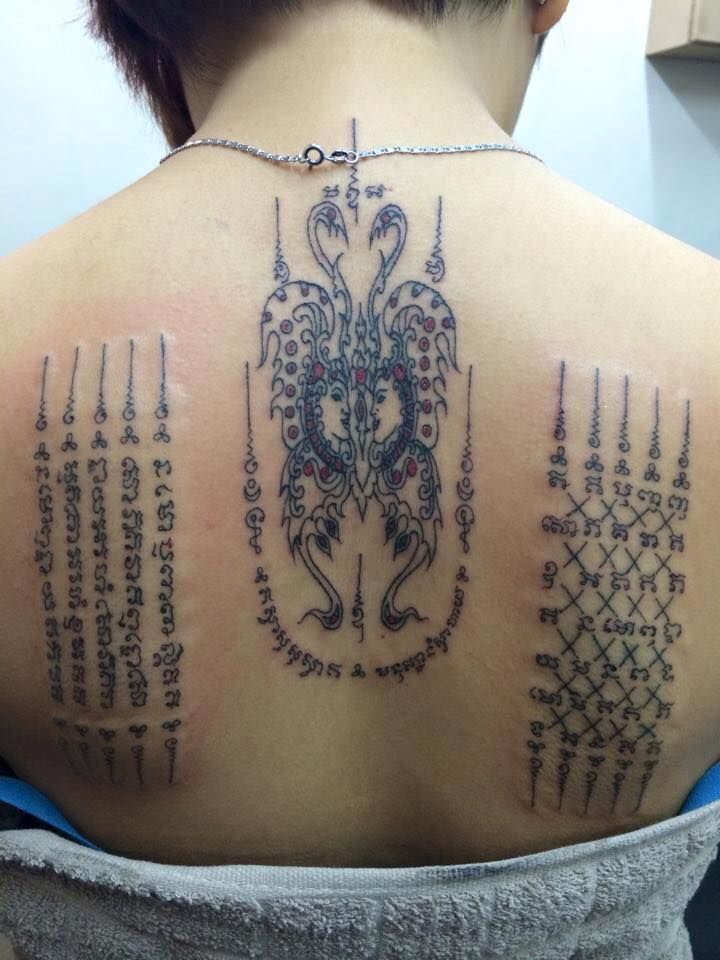
Sak yant tattoos are not simply inked onto the skin; they are imbued with spiritual energy through traditional rituals and ceremonies. Monks or ajarns (masters) perform the tattooing process, using specialized bamboo needles and chanting sacred incantations. These rituals infuse the tattoo with magical properties, enhancing its spiritual potency.
Sak yant tattoos hold immense cultural significance in Thai society. They are perceived as a reflection of one’s beliefs, values, and personal journey. These tattoos are not merely decorative; they are regarded as sacred talismans that provide protection, guidance, and a connection to the spiritual realms.
Sak Yant Tattoo Meaning: Unveiling the Mystery
Sak yant tattoos hold significant meaning for those who choose to adorn their bodies with these powerful symbols. Each design carries unique symbolism, representing various aspects of life, spirituality, and personal beliefs. Let’s explore some common meanings associated with sak yant tattoos:
Protection and Spiritual Guidance
Sak yant tattoos, deeply rooted in Thai culture and Buddhist beliefs, hold significant meaning and are sought after as a means of protection against evil spirits and negative energies. These sacred designs are believed to offer spiritual guidance and act as a powerful shield, safeguarding the wearer from harm.
The art of sak yant tattooing dates back centuries and is intricately tied to the practices of traditional Buddhist monks known as “ajarns.” Ajarns are highly respected individuals who possess extensive knowledge of ancient texts, incantations, and magical symbols. They are considered masters of this art form and are entrusted with the responsibility of creating and imparting sak yant tattoos.
The designs of sak yant tattoos are carefully crafted, combining intricate patterns and mythical creatures. Each element within the design holds symbolic significance, representing various qualities and virtues. For example, the roaring tiger might embody strength and courage, while the serpent could symbolize protection and wisdom. These elements are interwoven and arranged in a specific manner, guided by the ajarn’s expertise and the wearer’s personal intentions.
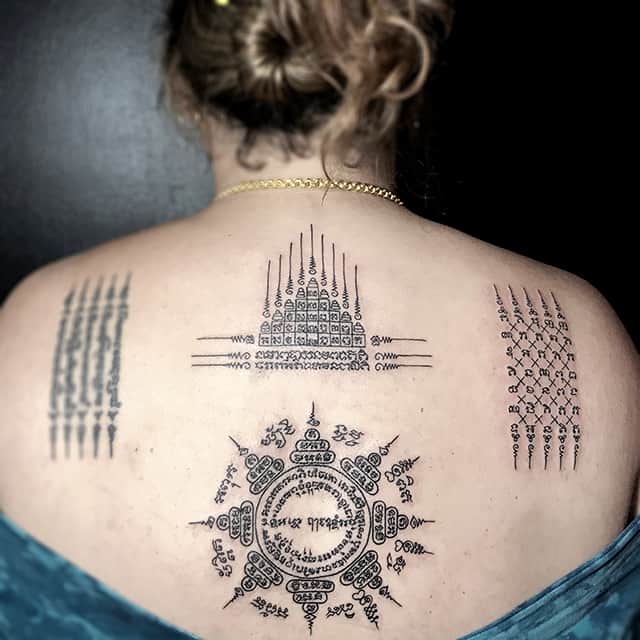
The process of receiving a sak yant tattoo is not merely about getting inked; it involves a spiritual ritual that is meant to invoke divine intervention. The wearer engages in a series of preparatory practices, such as observing certain dietary restrictions and refraining from impure thoughts or actions. This serves to purify the mind, body, and spirit before the tattooing ceremony.
During the actual tattooing session, the ajarn performs a chant or blessing, infusing the tattoo with spiritual energy. This blessing is believed to activate the protective qualities of the sak yant design, empowering it to serve as a shield against malevolent forces. It is thought that these tattoos possess a connection to the supernatural realm, enabling them to ward off evil spirits and deflect negative energies.
The wearer of a sak yant tattoo carries with them the belief that they are constantly guided and protected by the spiritual forces embodied within the design. These tattoos serve as a reminder to stay on the path of righteousness, as they symbolize a deeper commitment to leading a virtuous life.
In Thai society, sak yant tattoos are not limited to any specific demographic or social group; they transcend boundaries and are sought after by people from all walks of life. They can be found adorning the bodies of soldiers, police officers, celebrities, and ordinary individuals alike. The allure of sak yant tattoos lies not only in their aesthetic appeal but also in the profound sense of assurance and protection they provide.
It is important to note that sak yant tattoos are deeply rooted in cultural and religious traditions. If one wishes to get a sak yant tattoo, it is crucial to approach the practice with respect and understanding. Seeking out an experienced and reputable ajarn who follows ethical practices is essential to ensure the authenticity and integrity of the tattooing process.
Strength and Courage
Sak yant tattoos are a traditional form of tattoo art that originated in Southeast Asia, particularly in Thailand. These tattoos hold deep cultural and spiritual significance, often serving as powerful symbols of strength and courage. The motifs used in sak yant tattoos, such as tigers, lions, or mythical warriors, are chosen specifically for their association with bravery and resilience.
The purpose of these tattoos is to provide a constant reminder to individuals to face challenges head-on, encouraging them to confront obstacles with unwavering determination. They act as a visual representation of one’s inner warrior spirit, instilling a sense of empowerment and confidence.
Tigers, for example, are commonly depicted in sak yant tattoos due to their reputation as fierce and powerful creatures. They symbolize courage, strength, and protection. By having a tiger motif inked on their bodies, individuals hope to embody these qualities and draw upon them when facing difficulties in their lives.

Lions, known as the king of the jungle, represent leadership, bravery, and fearlessness. Having a lion tattooed on one’s skin inspires individuals to embrace their inner strength and take charge of their lives, standing up against adversity.
Mythical warriors, like the legendary Muay Thai fighter Hanuman or the fearless goddess Kali, are also popular choices for sak yant tattoos. These figures epitomize the ability to overcome obstacles and fight against all odds. By bearing the image of such warrior deities, individuals seek to harness their energy and adopt their indomitable spirit.
In addition to their symbolic meaning, sak yant tattoos are traditionally believed to possess magical powers. It is believed that the sacred chants and blessings performed by the skilled monks during the tattooing process imbue the tattoos with protective qualities. Many people see these tattoos as not only a source of inspiration but also as a form of spiritual armor that wards off negative energies and brings good fortune.
Prosperity and Good Fortune
Sak Yant tattoos have deep cultural and spiritual significance in Thailand. They are traditional tattoos that hold symbolic meanings and incorporate various elements such as lotus flowers, sacred geometries, and mythical creatures into their designs. The purpose of these tattoos is to provide the wearer with visual affirmations that serve as reminders of their potential to thrive and achieve abundance and success.
The lotus flower is one of the most common symbols found in Sak Yant tattoos. It represents purity, enlightenment, and spiritual growth. The lotus grows out of muddy waters, yet remains untouched by its surroundings, symbolizing the ability to rise above challenges and obstacles in life. By including lotus flowers in the tattoo design, it signifies the wearer’s pursuit of spiritual and personal development.
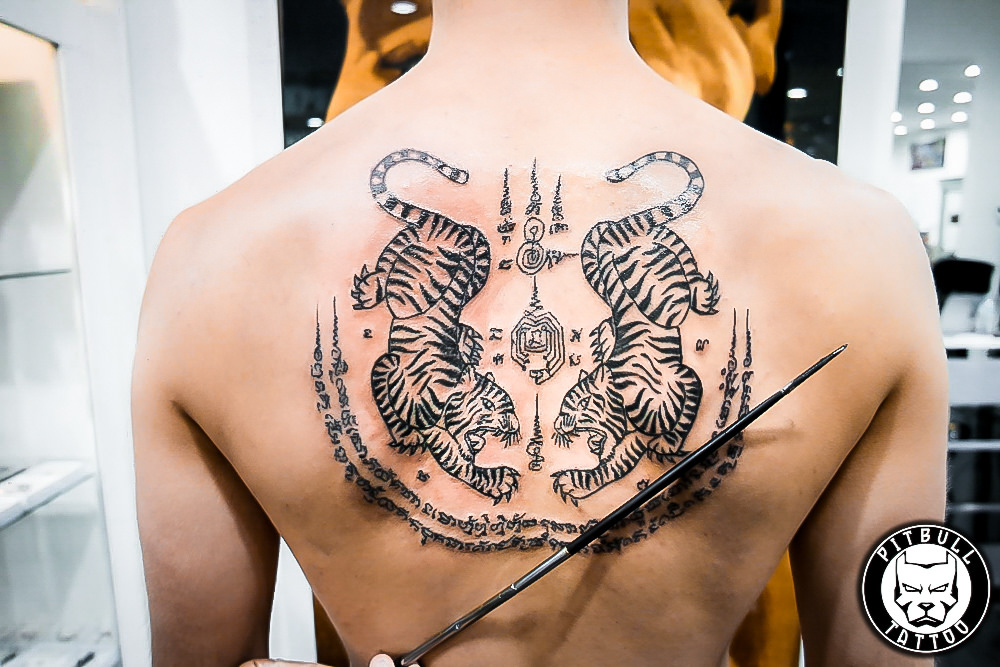
Sacred geometries are another prominent element incorporated into Sak Yant tattoos. These geometric patterns, such as intricate mandalas or yantras, hold powerful spiritual meanings. They are believed to represent cosmic energies and serve as a guide for meditation and focus. Including sacred geometries in the tattoo design enhances its connection to higher realms and aids the wearer in finding inner balance and harmony.
Mythical creatures like dragons, tigers, and phoenixes are often featured in Sak Yant tattoos as well. These creatures carry specific symbolism and qualities that offer protection, strength, and courage to the wearer. Dragons represent wisdom and power, while tigers symbolize bravery and fearlessness. Phoenixes, on the other hand, signify rebirth, transformation, and resilience. By incorporating these mythical creatures into the tattoo, the wearer embraces these qualities and seeks to embody them in their own life journey.
Love and Relationships
Sak Yant tattoos, deeply rooted in Thai culture and spirituality, hold significant meaning beyond their aesthetically pleasing designs. While they are commonly known for their association with protection and spiritual beliefs, these tattoos also embody emotions such as love, affection, and the intricate dynamics of relationships.
One of the prominent symbols used in Sak Yant tattoos to represent love is the intertwining serpents or mythical creatures. The entwined serpents symbolize the union of souls, depicting two individuals intertwined in a loving embrace. This imagery reflects the deep emotional connection between two people and signifies the unbreakable bond they share. It serves as a visual representation of the harmony and oneness that can be achieved within a loving relationship.
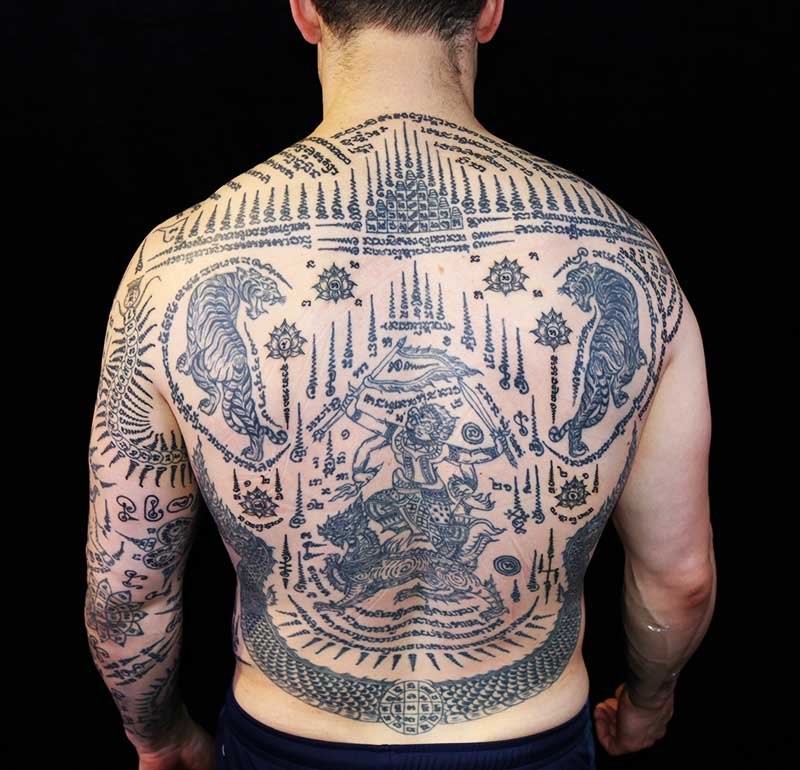
Furthermore, Sak Yant tattoos featuring these intricate designs can also express affection and devotion towards loved ones. They act as a tribute to the significant role that loved ones play in our lives and showcase the appreciation and gratitude we feel towards them. These tattoos serve as a constant reminder of the importance of nurturing meaningful connections and cherishing the bonds we have with those who are dear to us.
In Thai culture, where family and community values hold great importance, Sak Yant tattoos can also symbolize the unity and strength of the collective. They showcase the interconnectedness between individuals and emphasize the power of relationships in shaping one’s life. These tattoos not only celebrate the love shared between couples but also highlight the significance of familial ties, friendships, and the broader sense of belonging within a community.
Spiritual Enlightenment
Sak yant tattoos are intricately woven into the spiritual fabric of Thai culture, representing a profound journey towards enlightenment. These sacred designs go beyond mere aesthetic appeal, as they carry deep personal beliefs and establish an intimate connection with the divine.
Embarking on the path of sak yant tattooing signifies a commitment to one’s spiritual growth and a desire to explore the realms of consciousness. Each tattoo is carefully chosen based on its symbolic meaning and the individual’s unique spiritual aspirations. The process of receiving a sak yant tattoo involves more than just ink on skin; it is a transformative experience that encompasses both body and soul.
These tattoos serve as visual mantras, encapsulating ancient wisdom and guiding the wearer on their path to spiritual awakening. The symbols and motifs etched onto the skin hold significant spiritual power, acting as a conduit for divine energy to flow through the individual. They serve as reminders of the wearer’s intentions, constantly reinforcing their commitment to self-discovery and higher consciousness.
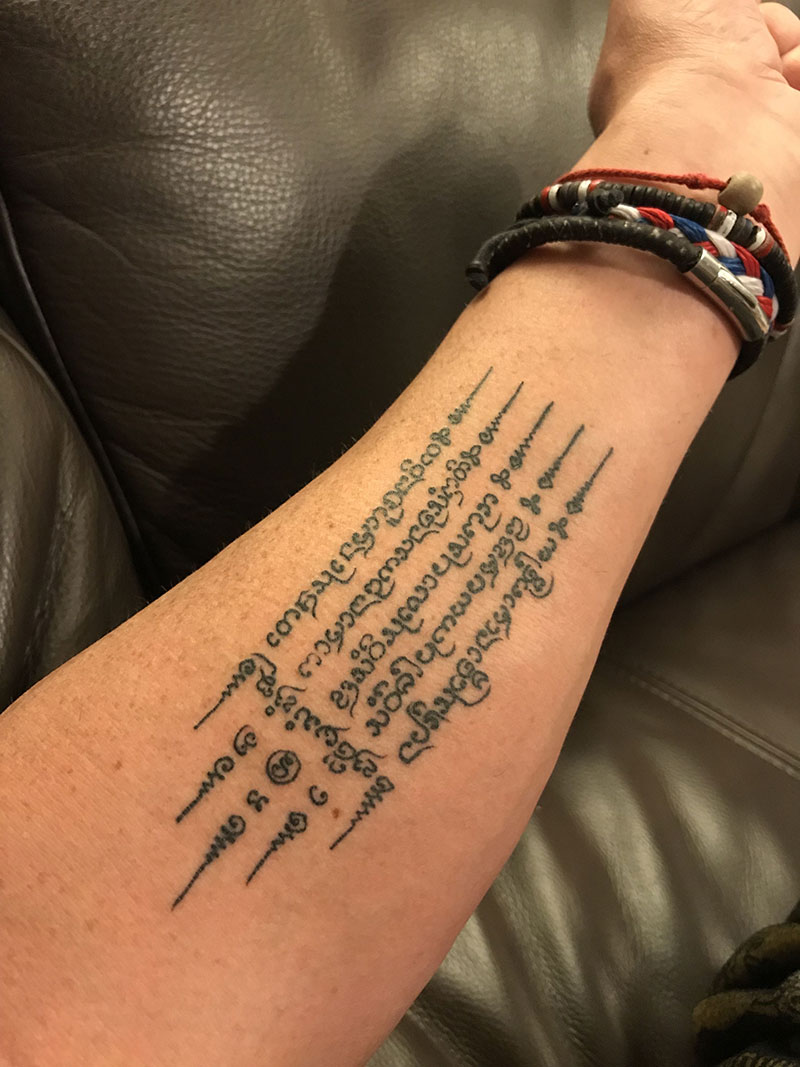
The designs themselves possess deep-rooted meanings, often embodying qualities such as courage, protection, love, or wisdom. For example, the Hah Taew (Five Lines) design is a popular choice, representing five sacred spells that grant protection from harm and bring good fortune. Other common symbols include the tiger, which symbolizes strength and fearlessness, and the lotus flower, which represents purity and spiritual growth.
The process of receiving a sak yant tattoo is not merely a transactional exchange between the wearer and the tattoo artist. It is a sacred ritual that involves seeking the blessing of a master tattooist, usually a monk or a spiritually revered figure. The ceremony can be elaborate and may involve chanting, meditation, and the infusion of spiritual energy into the tattoo.
Through this spiritual journey, wearers of sak yant tattoos seek a deeper understanding of themselves and their place in the universe. They strive to cultivate inner peace, mindfulness, and harmony with the divine. The tattoos become a constant reminder of their commitment to spiritual development and serve as powerful talismans, guarding against negative influences and guiding them on their path.
The Power of Symbols: Unlocking Sak Yant Tattoo Meanings
Sak Yant tattoos encompass a wide array of symbols, each representing different aspects of life, spirituality, and personal beliefs. Let’s explore some of the most common sak yant tattoo meanings:
Hah Taew
The five-line design in question is known as a sak yant tattoo, which holds immense popularity among tattoo enthusiasts. This particular design is revered for its multifaceted symbolism and is widely sought after for the benefits it is believed to confer upon the wearer.
At its core, this five-line sak yant design represents protection against harm. It is believed to possess inherent powers that shield the individual from negative energies, accidents, and malevolent forces. The lines are thought to act as spiritual armor, safeguarding the bearer from physical and metaphysical dangers.
Beyond protection, this design also symbolizes fortune and fulfillment in various aspects of life. It is believed to attract positive energy and bring good luck, enhancing the wearer’s overall prosperity. The sak yant design is often associated with attracting wealth and abundance, leading to financial success and material well-being.
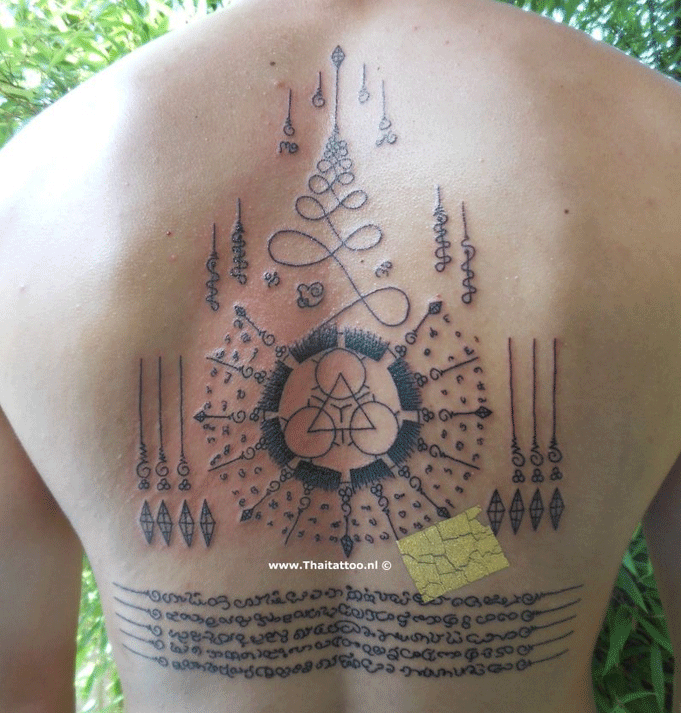
Moreover, this design encompasses a broader spectrum of life’s facets, including love, career, and health. In matters of romance and relationships, it is believed to foster harmony, strengthen connections, and provide guidance in matters of the heart. As for one’s professional endeavors, the tattoo is thought to bring success, opportunities, and advancement, enabling individuals to thrive in their chosen careers.
Furthermore, this sak yant design is linked to the enhancement of health and well-being. It is believed to promote physical vitality, mental clarity, and emotional balance. Some interpret it as a source of healing energy, aiding in the recovery from illnesses or injuries and maintaining overall wellness.
The popularity of this particular sak yant design stems from its comprehensive nature, encompassing multiple aspects of life and offering an array of potential benefits to the wearer. Its aesthetic appeal combined with the profound symbolism it carries makes it a desirable choice for those seeking protection, fortune, and fulfillment.
Gao Yord
Translated as Nine Peaks, this sak yant tattoo is a powerful symbol that encapsulates profound spiritual concepts and aspirations. Rooted in Thai culture and Buddhist beliefs, it represents the quest for spiritual enlightenment, guidance, and the attainment of higher consciousness.
The name “Nine Peaks” refers to the nine sacred mountains in Buddhist cosmology, each representing a stage or peak on the path to spiritual awakening. These peaks symbolize virtues and qualities necessary to navigate life’s challenges successfully. The tattoo acts as a spiritual compass, providing guidance and protection as one strives to overcome obstacles and reach a state of inner harmony.
The sak yant tattoo itself is an ancient form of body art practiced in Southeast Asia, where intricate designs are inked onto the skin using traditional methods. Beyond its aesthetic appeal, the sak yant carries deep spiritual significance. It is believed that the tattoo’s sacred symbols and patterns become imbued with mystical power, serving as a visual reminder of one’s spiritual goals and values.
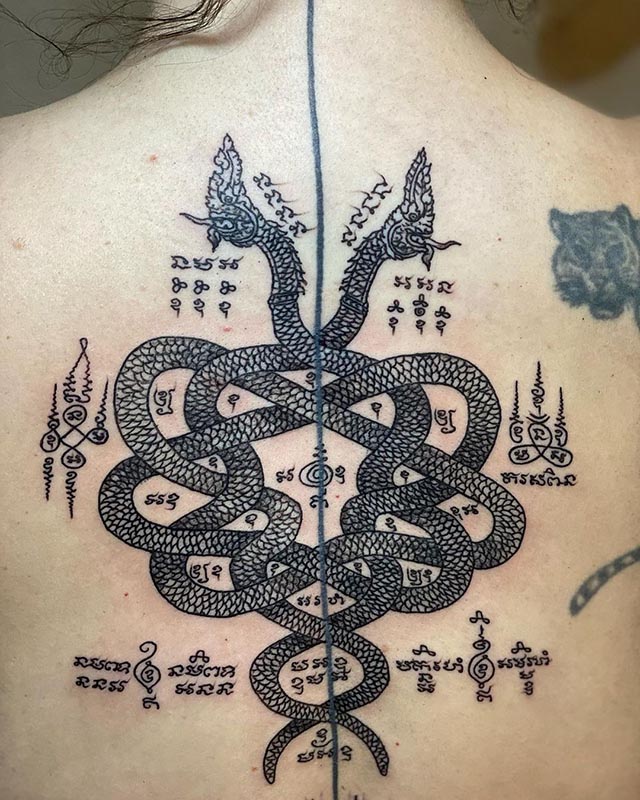
Incorporating the concept of Nine Peaks into a sak yant design infuses it with transformative energy. The symbolism of the tattoo encourages individuals to embark on a lifelong journey of self-discovery and personal growth. It serves as a constant reminder to stay focused on the path towards enlightenment and to strive for higher levels of consciousness.
By wearing the Nine Peaks sak yant tattoo, individuals seek to cultivate virtues such as wisdom, compassion, patience, and integrity. These qualities act as guiding principles, helping individuals make conscious choices and navigate life’s complexities with clarity and grace. The tattoo becomes a tangible representation of one’s commitment to personal development and spiritual evolution.
Furthermore, the sak yant tattoo also offers protection and wards off negative energies. It is believed that the sacred symbols and intricate patterns create a shield of spiritual defense around the wearer, safeguarding them from harm and ill-intentioned forces. This aspect of the tattoo adds an additional layer of significance, as it provides a sense of security and confidence in the face of life’s challenges.
Paed Tidt
The Eight Directions, also known as the “Ashtamangala,” is a powerful sak yant symbol that holds great significance and offers comprehensive protection from all directions. This ancient symbol embraces the belief that it can ward off negative energies and bring good fortune, particularly during travels and adventures.
The symbol itself consists of eight distinct elements, each representing a specific direction and carrying its own symbolic meaning. These directions include north, south, east, west, northeast, northwest, southeast, and southwest. By encompassing all these directions, the Eight Directions symbolizes complete protection and ensures that no harm can come from any quarter.
In Thai culture, sak yant tattoos are regarded as sacred and possess mystical powers. They are traditionally created by tattoo masters who infuse them with spiritual energy during the process. The Eight Directions symbol, in particular, is highly sought after by individuals seeking extra protection during their journeys and endeavors.
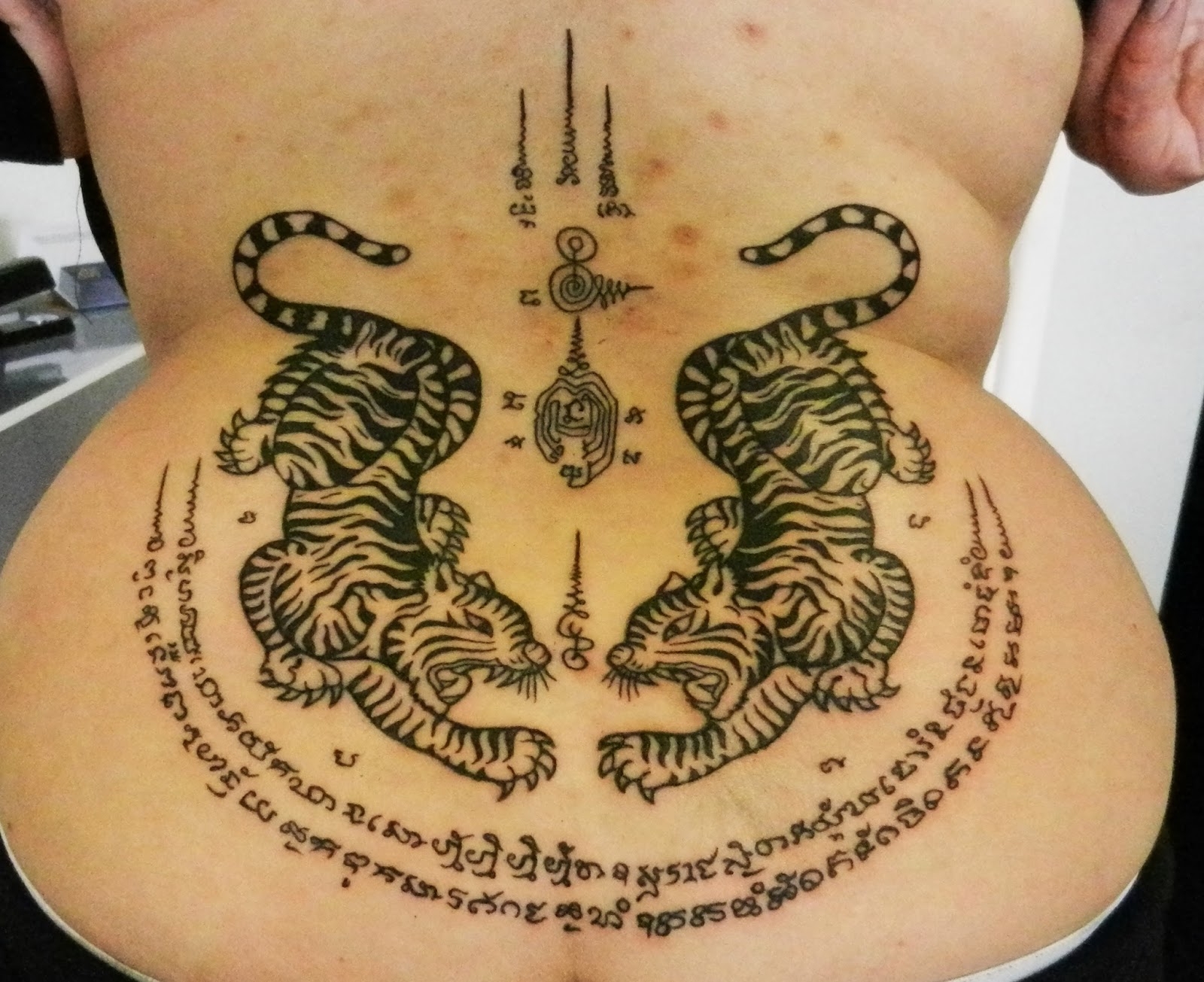
This symbol is believed to grant safety and shield the bearer from accidents, misfortune, and negative influences encountered while traveling. It serves as a spiritual compass, guiding and safeguarding the individual in unfamiliar territories. Whether embarking on a physical journey or navigating through life’s challenges, the Eight Directions symbol is thought to ensure a smooth and auspicious passage.
Moreover, this powerful sak yant symbol is not limited to physical protection alone but extends its influence to various aspects of life. It is said to bring luck, fortune, and opportunities in different ventures, allowing individuals to face new experiences with confidence and optimism.
The Eight Directions symbol embodies the concept of harmonious balance and unity between opposing forces. It represents the interconnectedness of all directions and the continuous cycle of life. By wearing or displaying this symbol, individuals seek to align themselves with these universal energies, fostering a sense of harmony and protection throughout their journeys.
Hanuman
The sak yant tattoo, prominently featuring the revered monkey deity Hanuman, holds great significance and conveys a profound meaning. Hanuman is a prominent figure in Hindu mythology and is widely venerated for his extraordinary strength, unwavering courage, and unwavering loyalty.
Depicting Hanuman in a sak yant tattoo serves as a powerful symbol of these admirable qualities. It represents the immense physical and mental strength possessed by Hanuman, which becomes a source of inspiration and motivation for those who seek to embody similar attributes in their own lives.
The tattoo carries an aura of invincibility and resilience, making it particularly appealing to individuals involved in martial arts or those aiming to enhance their physical abilities. By embracing the image of Hanuman on their bodies, practitioners believe they can tap into the deity’s legendary strength and channel it into their own combat skills, enabling them to overcome challenges and opponents with greater determination and effectiveness.
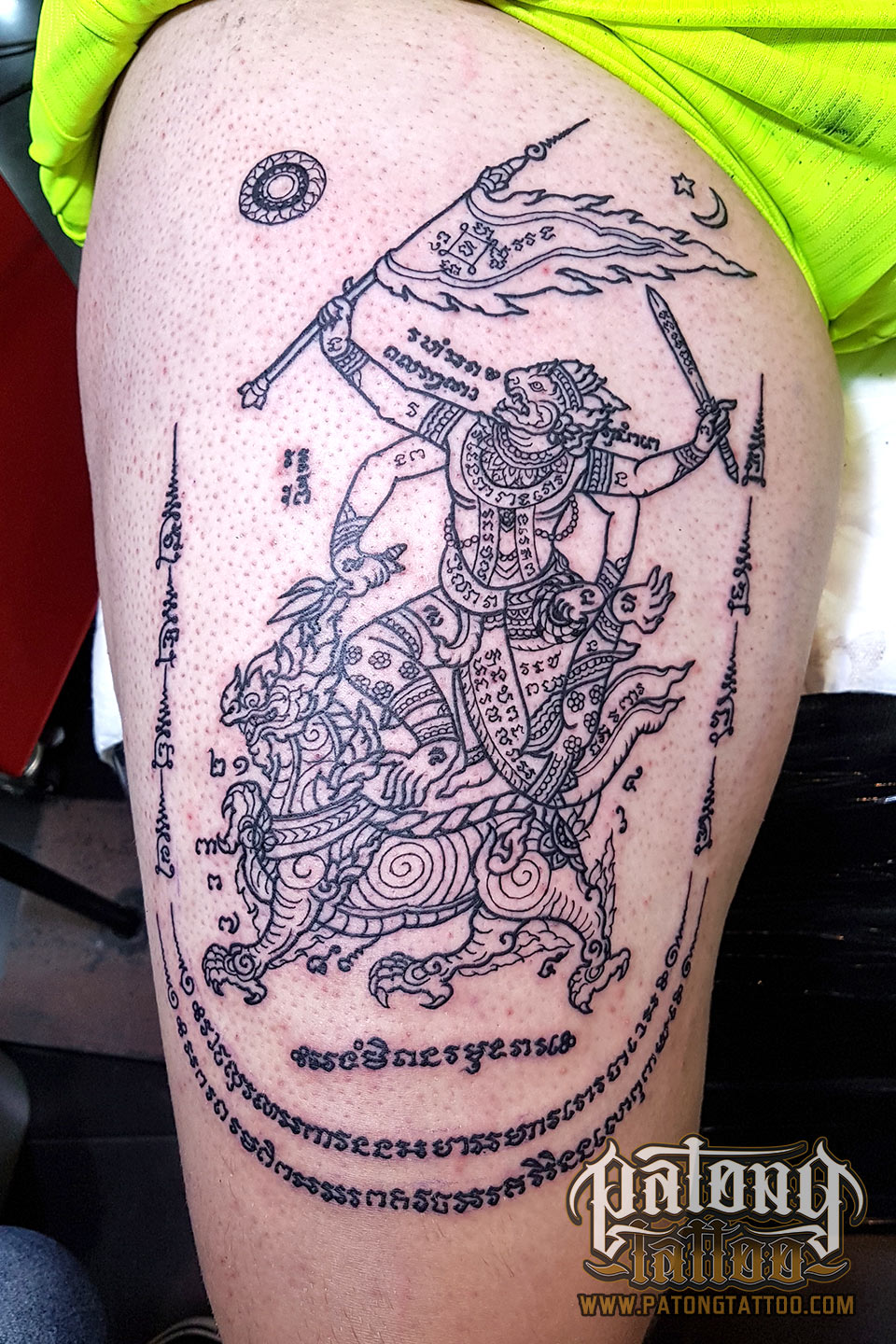
Aside from martial arts enthusiasts, the sak yant tattoo featuring Hanuman also attracts individuals facing personal obstacles or adversity. It serves as a reminder that just as Hanuman overcame numerous trials and tribulations during his journey, they too possess the inner strength and tenacity to conquer their own difficulties.
Moreover, Hanuman symbolizes unwavering loyalty and devotion. He was a devoted disciple of Lord Rama, displaying unwavering commitment and selflessness towards his cause. The inclusion of Hanuman in the sak yant tattoo signifies the wearer’s allegiance and faithfulness to their chosen path, whether it be a martial art discipline, a spiritual journey, or any pursuit requiring dedication and perseverance.
Suea
The Suea, also known as the tiger, is a captivating creature that embodies an array of powerful qualities. Its essence evokes images of fierce strength, unwavering bravery, and formidable protection against evil forces. These attributes have made the tiger a popular symbol among warriors throughout history, as well as individuals seeking to cultivate inner fortitude.
The Suea’s association with strength stems from its physical prowess. Tigers are renowned for their imposing size, muscular build, and remarkable agility. Their sheer power allows them to overpower prey, making them apex predators in their natural habitat. This physical might inspires admiration and awe, symbolizing the embodiment of raw strength.
Bravery is another characteristic synonymous with the Suea. Tigers exhibit tremendous courage when facing various challenges in their environment. Whether engaging in territorial disputes or hunting formidable prey, these majestic creatures fearlessly confront adversity. Their unwavering determination serves as a reminder of the importance of standing firm in the face of danger, inspiring individuals to cultivate bravery within themselves.
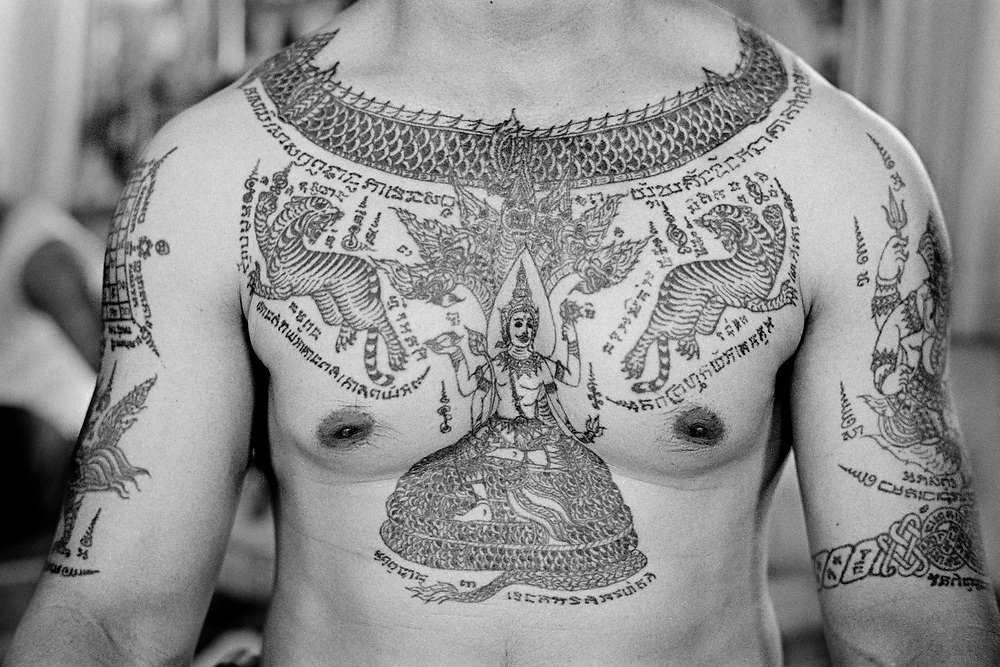
Protection against evil forces is a crucial aspect associated with the Suea. The tiger is often seen as a guardian figure, warding off malevolent spirits and providing a sense of security. In many cultures, artwork and sculptures depicting tigers are placed at entrances or used as talismans to protect homes and individuals from harm. The Suea’s presence is believed to create a shield against negative energies, ensuring safety and well-being.
Warriors have long revered the Suea due to its embodiment of strength, bravery, and protection. The tiger’s qualities align closely with the values sought after by soldiers and fighters. The symbolism of the Suea resonates with those who face battle, representing the indomitable spirit required to overcome adversaries and protect one’s comrades. Warriors often invoke the spirit of the tiger, drawing inspiration from its ferocity and resilience in the face of adversity.
Beyond warriors, individuals from all walks of life are attracted to the Suea as a symbol of inner fortitude. The tiger serves as a powerful metaphor for harnessing personal strength and courage. People seeking to overcome challenges, pursue their dreams, or find the determination to face life’s obstacles often draw inspiration from the Suea. It reminds them that they possess the innate ability to tap into their own reservoirs of strength, emboldening them to confront difficulties head-on.
These are just a few examples of the rich tapestry of sak yant tattoo meanings. Each design carries its own significance, offering wearers a deeply personal connection to their spiritual journey.
Conclusion: Sak Yant Tattoo Meaning
Sak yant tattoos are more than just intricate designs etched onto the skin; they carry deep spiritual meaning, cultural significance, and a connection to centuries-old traditions. These sacred tattoos serve as powerful symbols of protection, strength, enlightenment, and love. Rooted in Thai culture and influenced by Buddhism, they are a testament to the rich heritage of Southeast Asia. If one embarks on the journey of getting a sak yant tattoo, it is crucial to approach it with respect, understanding, and an appreciation for the cultural context in which they thrive.
Intriguing and captivating, sak yant tattoos are an embodiment of spirituality, personal beliefs, and the desire for a deeper connection with the divine. As these mystical designs continue to mesmerize people across the globe, may their profound meanings and enchanting origins inspire us to explore the depths of our own souls.

I am Harvey Berry, a tattoo enthusiast who has immersed himself in the diverse world of ink, passionately exploring the beauty and artistry within each tattoo. My mission extends beyond uncovering the aesthetics of tattooing; it involves sharing in-depth knowledge across all aspects of this art form.
Fueled by genuine curiosity and love for every facet of tattooing, I have diligently crafted well-researched articles, with a special focus on the Tattoo Meaning of Impeccable Nest section. Here, my aim is to help the tattoo community gain a deeper understanding of the meanings and values embedded in each tattoo.
One of my primary goals is to encourage responsible decision-making when it comes to getting inked. I recognize that choosing to get a tattoo is a significant personal decision that requires careful consideration. Hence, I provide diverse resources covering the meaning of tattoos, the tattooing process, aftercare tips, and other valuable information.
Whether you are a seasoned tattoo enthusiast or embarking on your first exploration of the world of body art, I aspire to be a reliable resource for you at every step of your journey. I hope that my extensive knowledge of tattoos, especially in the Tattoo Meaning section, will assist you in finding inspiration to express yourself through the art of tattoos.
